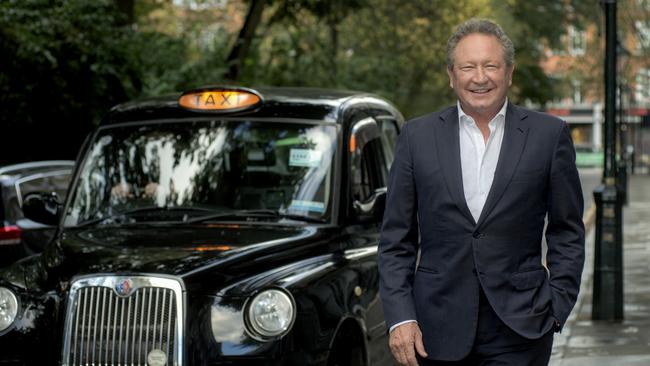Andrew Forrest says ‘hundreds of billions’ of dollars needed for Fortescue green projects
Andrew Forrest admits it will cost ‘hundreds of billions’ of dollars to pursue the green dream, but says buyers and investors are lining up.

Andrew Forrest says the company is in detailed talks with buyers for the company’s future green energy and hydrogen products, but told shareholders it would cost “hundreds of billions of dollars” to make Fortescue’s ambitions of becoming a global green energy powerhouse to come true.
But the Fortescue founder assured shareholders that global investors were already lining up to invest in Fortescue Future Industry projects, as well as buyers for its output of hydrogen and energy.
“Fortescue cash flows will pay the wages and improve the studies adding massive value by creating the projects, delivering the technology and meeting our customers’ needs,” he said.
“The implementation capital – which over time will be hundreds of billions of dollars – much of that capital will be … funded by the world’s greatest institutions, who must invest in humanity’s journey to a zero carbon future.”
The Australian revealed on Monday that the total cost to build even a proportion of FFI’s project pipeline could top $US145bn ($195bn).
Mr Forrest told shareholders the company – a subsidiary of miner Fortescue – was on the cusp of signing an agreement to supply hydrogen as an aviation fuel to a US buyer.
Fortescue signed a memorandum of understanding with UK construction giant JC Bamford Excavators and Ryze Hydrogen on October 31 for the supply of 1.5 million tonnes of hydrogen by 2030, or about 10 per cent of the company’s planned output.
Fortescue has been under increasing pressure from institutional investors to back up promises of future growth through its Fortescue Future Industries subsidiary with detailed business cases.
While he gave no new details of FFI’s projects in his address to shareholders at Fortescue’s annual meeting on Tuesday, Mr Forrest said the JCB and Ryze deal had “broken the dam” on demand for hydrogen, and he was now fielding calls from around the world seeking access to FFI’s future output.
Mr Forrest’s optimism came despite the fact that the company has not disclosed the completion of a feasibility study on a single one of its projects, and is yet to outline the likely cost and return of the push into green and renewable energy.
The iron ore magnate told shareholders the company would produce its “first molecule of hydrogen” in early 2022.
“We are in negotiations as I speak for major global green offtake agreements,” he said.
“In the coming days we’ll be announcing a memorandum of understanding for a potential global aviation hydrogen supply agreement with LA-based universal hydrogen … with hydrogen powering fuel cell engines.”
Dr Forrest did not preside over the Fortescue annual meeting, leaving deputy chairman Mark Barnaba to run the meeting in Perth as he was still in Glasgow following the COP26 climate summit.
Fortescue also flagged plans to issue green bonds to fund plans to decarbonise its own operations and build the massive pipeline of renewable energy projects earmarked through FFI.
Fortescue released a framework to the market on Tuesday, pitching its credentials to green debt markets as it looks for ways to fund sustainability projects.
While Fortescue has signalled its intention to tap green financing markets, The Australian revealed on Monday that the total cost to build even a proportion of FFI’s project pipeline could top $US145bn.
The company said ahead of its AGM in Perth that the framework was designed to allow the company to tap “green, social, and sustainability financing instruments” – including bonds, loans, bank guarantees, letters of credit, and asset-backed securities.
It said it could use the proceeds of any debt raised to fund spending for FFI projects, the acquisition of renewable energy and sustainability-focused companies, and decarbonisation projects planned by Fortescue for its iron ore operations.
Fortescue also flagged the use of green debt to fund energy intensive magnetite iron ore projects such as its Iron Bridge project in the Pilbara, where it has “at least 20 per cent higher energy efficiency than conventional magnetite processing”.
The framework also puts a structure around Fortescue’s promises that any FFI projects that get the go-ahead will raise their own debt and equity, secured against the assets under construction, with no recourse to the iron ore major’s balance sheet.
The company said it would use any funds raised towards renewable energy generation development, energy efficiency projects, green hydrogen and ammonia plants, green transport solutions and “eligible social projects”, including procurement spending with Indigenous-owned groups.
Fortescue joins a long list of corporations looking to tap debt investors focused on environmentally friendly projects.
US corporations raised about $US47bn through issuing green bonds in the first 10 months of 2021, according to a recent report in the Wall Street Journal, and global sales of green bonds have so far topped $US447bn – nearly double the $US234bn raised in 2020, according to Bloomberg.
Billionaire packaging magnate Anthony Pratt’s US business has long trumpeted the use of 30-year green bonds to fund its North American growth, and on Tuesday Ford broke green bond records by selling $US2.5bn in 10-year debt, having gone out the market looking for only $US1bn.
Fortescue shares closed up 26c at $14.59.



To join the conversation, please log in. Don't have an account? Register
Join the conversation, you are commenting as Logout